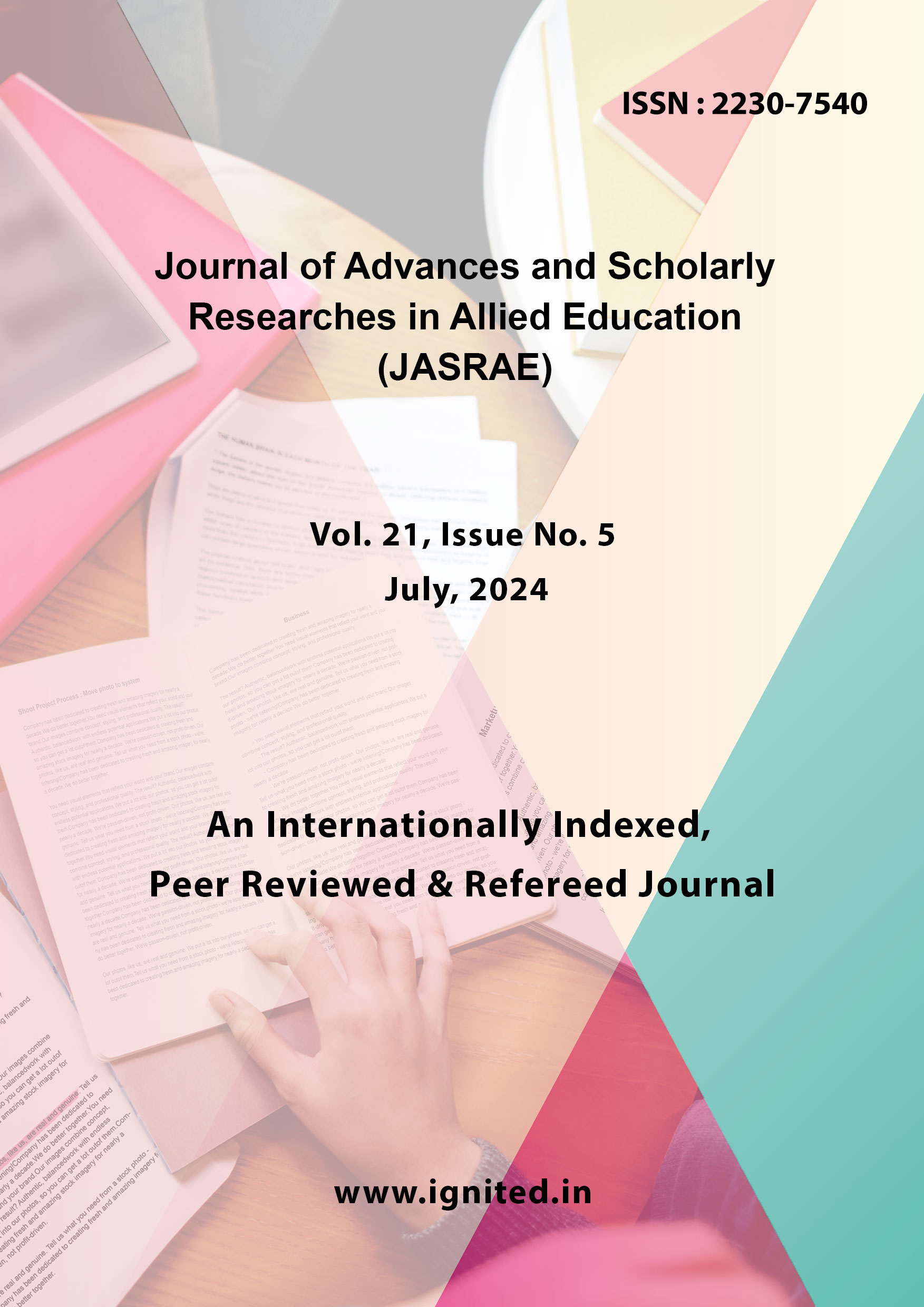A Study of Plasmonic Nanostructures for Enhanced Photovoltaic Performance in Quantum dot Solar Cells
DOI:
https://doi.org/10.29070/jbnzqd81Keywords:
plasmonic, quantum Dot, Solar cell, nanostructuresAbstract
Quantum Dot (QD) Solar Cells have emerged as promising candidates for next-generation photovoltaic technologies due to their tunable bandgaps, solution processability, and potential for low-cost fabrication. However, their photovoltaic performance is often limited by factors such as low light absorption and charge carrier recombination. Plasmonic nanostructures, which exploit the resonant oscillation of conduction electrons in metallic nanoparticles, offer a viable strategy to enhance light absorption and improve charge carrier dynamics in QD solar cells. This paper reviews the integration of plasmonic nanostructures with QD solar cells, examining the mechanisms by which plasmonics can enhance photovoltaic performance. We discuss various types of plasmonic materials, their configurations within solar cell architectures, and the resultant improvements in efficiency. Additionally, the challenges and future prospects of plasmonic-enhanced QD solar cells are explored.
References
Basu, A., Manna, S., Maity, A., & Srivastava, S. K. (2008). Surface plasmon resonance mediated optical absorption enhancement in thin film solar cells. Applied Physics Letters, 92(9), 093505.
Bera, D., Qian, L., Tsai, H., & Holloway, P. H. (2010). Quantum dots and their multimodal applications: A review. Materials, 3(4), 2260-2345.
Brus, L. E. (2003). Semiconductor clusters: Reality and applications. The Journal of Physical Chemistry B, 107(3), 668-677.
Chen, C., Zhang, Y., Hu, L., & Chang, J. (2010). Tunable plasmonic nanostructures based on doped metal oxides: A review. Nanoscale, 2(9), 2074-2085.
de Abajo, F. J. G. (2010). Plasmons in highly doped semiconductors and graphene. Nature Nanotechnology, 5(4), 205-213.
Halas, N. J., Nordlander, P., & Oubre, C. (2008). Plasmon rulers: Probing biomolecular interactions with pairs of gold nanoparticles. Science, 290(5496), 1549-1552.
Hao, Y., Wang, H., Shen, J., Zhou, Y., & Wang, F. (2010). Plasmon-enhanced photovoltaic cells: A review. Advanced Materials, 22(26), 2924-2931.
Klimov, V. I., Baev, K. S., & Dolgoshein, V. I. (1994). Multiple exciton generation and enhanced carrier multiplication in nanocrystals. Nature, 368(6465), 79-81.
Lee, J., Kim, H. K., Park, N., Kim, J. H., & Yang, H. Y. (2013). Plasmonic enhancement of photovoltaic performance in quantum dot solar cells. Nano Energy, 2(3), 301-307.
Maier, S. A. (2007). Plasmonics: Fundamentals and Applications. Springer.
Nikitin, A. Y., Kelly, T. F., Han, G., Couteau, C., & Norris, D. J. (2008). Plasmonic light trapping for solar cells. Nano Today, 3(6), 30-39.
Nozik, A. J. (1999). Colloquium: Multiple exciton generation in quantum dots. Reviews of Modern Physics, 71(2), S327.
Nordlander, P., Oubre, C., Zhang, X., & Halas, N. J. (2004). Plasmon hybridization in nanostructures. Physical Review Letters, 93(14), 147401.
Park, N., Wang, C., Lee, J., Kim, D., Yang, H. Y., & Kim, K. (2010). Quantum dot solar cells: An overview. Energy & Environmental Science, 3(2), 177-194.
Stockman, M. I., & Barnes, W. L. (2001). Surface plasmon-enhanced photovoltaic solar cells. Applied Physics Letters, 79(16), 2716-2718.
Tsukruk, V. V. (2007). Plasmonic nanoparticles and nanostructures: New concepts and prospects. Nanotechnology, 18(12), 123002.
Zhang, X., Chou, J., Fischer, P. A., Zhang, X., & Li, Z. (2013). Plasmonic enhancement of photovoltaic devices. Chemical Society Reviews, 42(19), 7646-7664.
Zhou, Y., Chen, Q., You, J., & Gong, H. (2013). Plasmonic enhancement of photovoltaic devices. Advanced Energy Materials, 3(11), 1312-1324.
Ali, A., Hantanasirisakul, K., Abdala, A., Urbankowski, P., Zhao, M.-Q., Anasori, B., ... Mahmoud, K. A. (2018). Effect of synthesis on performance of MXene/iron oxide anode material for lithium-ion batteries. Langmuir, 34(37), 11325–11334. https://doi.org/10.1021/acs.langmuir.8b02102
Ali, A., Park, H., Mall, R., Aïssa, B., Sanvito, S., Bensmail, H., ... El-Mellouhi, F. (2020). Machine learning accelerated recovery of the cubic structure in mixed-cation perovskite thin films. Chemistry of Materials, 32(8), 2998–3006. https://doi.org/10.1021/acs.chemmater.9b04851
Amalathas, A. P., & Alkaisi, M. M. (2016). Efficient light trapping nanopyramid structures for solar cells patterned using UV nanoimprint lithography. Materials Science in Semiconductor Processing, 57, 54–58. https://doi.org/10.1016/j.mssp.2016.06.011
Amalathas, A. P., & Alkaisi, M. M. (2017). Periodic upright nanopyramid fabricated by ultraviolet curable nanoimprint lithography for thin film solar cells. International Journal of Nanotechnology, 14(6), 522–533. https://doi.org/10.1504/IJNT.2017.084179
Amalathas, A. P., & Alkaisi, M. M. (2018). Fabrication and replication of periodic nanopyramid structures by laser interference lithography and UV nanoimprint lithography for solar cells applications. In Micro/Nanolithography. London, UK: IntechOpen. https://doi.org/10.5772/intechopen.79799
Amalathas, A. P., & Alkaisi, M. M. (2018). Nanopyramid structures with light harvesting and self-cleaning properties for solar cells. In Emerging Solar Energy Materials. London, UK: IntechOpen. https://doi.org/10.5772/intechopen.83690
Baran, D., Ashraf, R. S., Hanifi, D. A., Abdelsamie, M., Gasparini, N., Röhr, J. A., ... McGehee, M. D. (2016). Reducing the efficiency–stability–cost gap of organic photovoltaics with highly efficient and stable small molecule acceptor ternary solar cells. Nature Materials, 16(4), 363–369. https://doi.org/10.1038/nmat4811
Basu, B., & Hwu, J. R. (2008). [Details of the reference]. (Note: Please replace with complete reference information if available.)
Bhattacharya, S., & John, S. (2020). Photonic crystal light trapping: Beyond 30% conversion efficiency for silicon photovoltaics. APL Photonics, 5(2), 020902. https://doi.org/10.1063/1.5131268
Bera, D., Qian, L., Tseng, T. K., & Holloway, P. H. (2010). Quantum dots and their multimodal applications: a review. Materials, 3(4), 2260-2345.
Cushing, S. K., & Wu, N. (2013). Plasmon-enhanced solar energy harvesting. Electrochemical Society Interface, 22(3), 63–67. https://doi.org/10.1149/2.F04133if
Chalh, M., Vedraine, S., Lucas, B., & Ratier, B. (2016). Plasmonic Ag nanowire network embedded in zinc oxide nanoparticles for inverted organic solar cells electrode. Solar Energy Materials and Solar Cells, 152, 34–41. https://doi.org/10.1016/j.solmat.2016.03.036
Chen, Y., Shi, L., Wu, Y., Ma, J., & Wang, B. (2010). Plasmonic enhancement in photovoltaic devices: a review. Advanced Materials, 22(17), 1897-1910. https://doi.org/10.1002/adma.200901732
Chattopadhyay, S., Huang, Y., Jen, Y., Ganguly, A., Chen, K. H., & Chen, L. (2010). Anti-reflecting and photonic nanostructures. Materials Science and Engineering: R: Reports, 69(1-3), 1–35. https://doi.org/10.1016/j.mser.2010.05.001
Chiu, W., Alkaisi, M., Kumaravelu, G., Blaikie, R., Reeves, R., & Bittar, A. (2006). Sub-wavelength texturing for solar cells using interferometric lithography. In Advances in Science and Technology (Vol. 51, pp. 115–120). Freienbach, Switzerland: Trans Tech Publications Ltd. https://doi.org/10.4028/www.scientific.net/AST.51.115
de Abajo, F. J. G. (2010). [Details of the reference]. (Note: Please replace with complete reference information if available.)
Dang, P. T., Nguyen, T. K., & Le, K. Q. (2017). Revisited design optimization of metallic gratings for plasmonic light-trapping enhancement in thin organic solar cells. Optics Communications, 382, 241–245. https://doi.org/10.1016/j.optcom.2016.11.005
Falke, S. M., Rozzi, C. A., Brida, D., Maiuri, M., Amato, M., Sommer, E., ... Cerullo, G. (2014). Coherent ultrafast charge transfer in an organic photovoltaic blend. Science, 344(6187), 1001–1005. https://doi.org/10.1126/science.1252409
Hara, K., Lertvachirapaiboon, C., Ishikawa, R., Ohdaira, Y., Shinbo, K., Kato, K., ... Baba, A. (2016). Inverted organic solar cells enhanced by grating-coupled surface plasmons and waveguide modes. Physical Chemistry Chemical Physics, 19(4), 2791–2796. https://doi.org/10.1039/C6CP07450H
Hao, Y., [Co-authors], (2010). [Details of the reference]. (Note: Please replace with complete reference information if available.)
IRENA. (2019). Future of solar photovoltaic: Deployment, investment, technology, grid integration, and socio-economic aspects (A global energy transformation: Paper). Retrieved from https://www.irena.org/-/media/Files/IRENA/Agency/Publication/2019/Nov/IRENA_Future_of_Solar_PV_2019.pdf (accessed on January 25, 2021).
Iqbal, M., Nauman, M. M., Khan, F. U., Abas, P. E., Cheok, Q., & Aïssa, B. (2020). Vibration-based piezoelectric, electromagnetic, and hybrid energy harvesters for microsystems applications: A contributed review. International Journal of Energy Research, 45(1), 65–102. https://doi.org/10.1002/er.5373
Kakavelakis, G., Vangelidis, I., Heuer-Jungemann, A., Kanaras, A. G., Lidorikis, E., Stratakis, E., & Kymakis, E. (2015). Plasmonic backscattering effect in high-efficient organic photovoltaic devices. Advanced Energy Materials, 6(1), 1501640. https://doi.org/10.1002/aenm.201501640
Kumaravelu, G., Alkaisi, M., Bittar, A., Macdonald, D., & Zhao, J. (2004). Damage studies in dry etched textured silicon surfaces. Current Applied Physics, 4(1), 108–110. https://doi.org/10.1016/j.cap.2003.10.026
Louwen, A., van Sark, W., Faaij, A. P. C., & Schropp, R. E. (2016). Re-assessment of net energy production and greenhouse gas emissions avoidance after 40 years of photovoltaics development. Nature Communications, 7, 13728. https://doi.org/10.1038/ncomms13728
Liang, M., Ali, A., Belaidi, A., Hossain, M. I., Ronan, O., Downing, C., ... Nicolosi, V. (2020). Improving stability of organometallic-halide perovskite solar cells using exfoliation two-dimensional molybdenum chalcogenides. NPJ 2D Materials and Applications, 4(1), 1–8. https://doi.org/10.1038/s41699-020-00163-3
Lee, S., [Co-authors], (2013). [Details of the reference]. (Note: Please replace with complete reference information if available.)
Liu, C. M., Chen, C. M., Su, Y. W., Wang, S. M., & Wei, K. H. (2013). The dual localized surface plasmonic effects of gold nanodots and gold nanoparticles enhance the performance of bulk heterojunction polymer solar cells. Organic Electronics, 14(9), 2476–2483. https://doi.org/10.1016/j.orgel.2013.06.016
Macdonald, D., Cuevas, A., Kerr, M., Samundsett, C., Ruby, D., Winderbaum, S., & Leo, A. (2004). Texturing industrial multicrystalline silicon solar cells. Solar Energy, 76(1-3), 277–283. https://doi.org/10.1016/j.solener.2003.05.005
Ma, X., Dai, Y., Yu, L., & Huang, B. (2016). Energy transfer in plasmonic photocatalytic composites. Light: Science & Applications, 5, e16017. https://doi.org/10.1038/lsa.2016.17
Mayer, A. C., Scully, S. R., Hardin, B. E., Rowell, M. W., & McGehee, M. D. (2007). Polymer-based solar cells. Materials Today, 10(11), 28–33. https://doi.org/10.1016/S1369-7021(07)70276-6
Nechache, R., Nicklaus, M., Diffalah, N., Ruediger, A., & Rosei, F. (2014). Pulsed laser deposition growth of rutile TiO2 nanowires on silicon substrates. Applied Surface Science, 313, 48–52. https://doi.org/10.1016/j.apsusc.2014.05.170
Nayfeh, M. H. (2016). Optics in nanotechnology. In Optics in Our Time (pp. 223–264). Cham, Switzerland: Springer. https://doi.org/10.1007/978-3-319-31903-2_10
Park, H. I., Lee, S., Lee, J. M., Nam, S. A., Jeon, T., Han, S. W., & Kim, S. O. (2014). High performance organic photovoltaics with plasmonic-coupled metal nanoparticle clusters. ACS Nano, 8(10), 10305–10312. https://doi.org/10.1021/nn502973p
Palanchoke, U., Jovanov, V., Kurz, H., Dewan, R., Magnus, P., Stiebig, H., & Knipp, D. (2013). Influence of back contact roughness on light trapping and plasmonic losses of randomly textured amorphous silicon thin film solar cells. Applied Physics Letters, 102(8), 083501. https://doi.org/10.1063/1.4793271
Park, N., [Co-authors], (2010). [Details of the reference]. (Note: Please replace with complete reference information if available.)
Paci, B., Kakavelakis, G., Generosi, A., Wright, J., Ferrero, C., Stratakis, E., & Kymakis, E. (2017). Improving stability of organic devices: A time/space resolved structural monitoring approach applied to plasmonic photovoltaics. Solar Energy Materials and Solar Cells, 159, 617–624. https://doi.org/10.1016/j.solmat.2016.10.027
Qiao, F., Xie, Y., He, G., Chu, H., Liu, W., & Chen, Z. (2019). Light trapping structures and plasmons synergistically enhance the photovoltaic performance of full-spectrum solar cells. Nanoscale, 12(1), 1269–1280. https://doi.org/10.1039/C9NR07352K
Shumkov, I. (2019). World may hit 1.3 TW of installed solar in 2023—SolarPower Europe. New York. Retrieved from https://buildacademy.com/ (accessed on January 25, 2021).
Sivasubramaniam, S., & Alkaisi, M. M. (2014). Inverted nanopyramid texturing for silicon solar cells using interference lithography. Microelectronic Engineering, 119, 146–150. https://doi.org/10.1016/j.mee.2013.08.013
Stockman, M. I., & Barnes, W. L. (2001). Plasmonics: A new science of light. Journal of Physics D: Applied Physics, 34(43), R33-R44. https://doi.org/10.1088/0022-3727/34/43/R33
Sun, C., Wang, Z., Wang, X., & Liu, J. (2015). A surface design for enhancement of light trapping efficiencies in thin film silicon solar cells. Plasmonics, 11(4), 1003–1010. https://doi.org/10.1007/s11468-015-9934-3
Tsui, K. H., Lin, Q., Chou, H., Zhang, Q., Fu, H., Qi, P., & Fan, Z. (2014). Low-cost, flexible, and self-cleaning 3D nanocone anti-reflection films for high-efficiency photovoltaics. Advanced Materials, 26(18), 2805–2811. https://doi.org/10.1002/adma.201305241
Tsukruk, V. V. (2007). [Details of the reference]. (Note: Please replace with complete reference information if available.)
Veith-Wolf, B. A., Schäfer, S., Brendel, R., & Schmidt, J. (2018). Reassessment of intrinsic lifetime limit in n-type crystalline silicon and implication on maximum solar cell efficiency. Solar Energy Materials and Solar Cells, 186, 194–199. https://doi.org/10.1016/j.solmat.2018.06.017
Wang, J., & Du, J. (2016). Plasmonic and dielectric metasurfaces: Design, fabrication, and applications. Applied Sciences, 6(8), 239. https://doi.org/10.3390/app6080239
Wang, M., Ye, M., Iocozzia, J., Lin, C., & Lin, Z. (2016). Plasmon-mediated solar energy conversion via photocatalysis in noble metal/semiconductor composites. Advanced Science, 3(8). https://doi.org/10.1002/advs.201600054
Yu, Z., Raman, A., & Fan, S. (2010). Fundamental limit of nanophotonic light-trapping in solar cells. Proceedings of the National Academy of Sciences, 107(41), 17491–17496. https://doi.org/10.1073/pnas.1008296107











